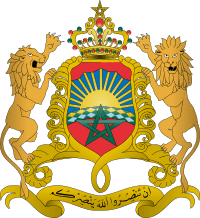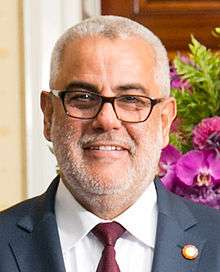Moroccan general election, 2016
| | |||||||||||||||||||||||||||||||||||||||||||||||||||||||||||||||||||||||||||||||||||||||||||
| |||||||||||||||||||||||||||||||||||||||||||||||||||||||||||||||||||||||||||||||||||||||||||
| |||||||||||||||||||||||||||||||||||||||||||||||||||||||||||||||||||||||||||||||||||||||||||
| |||||||||||||||||||||||||||||||||||||||||||||||||||||||||||||||||||||||||||||||||||||||||||
 |
| This article is part of a series on the politics and government of Morocco |
|
Monarchy |
|
Government |
| Judiciary |
|
General elections were held in Morocco on 7 October 2016.[2] The ruling Justice and Development Party remained the largest party, winning 125 of the 395 seats in the House of Representatives, a gain of 18 seats compared to the 2011 elections. Abdelillah Benkirane was reappointed Prime Minister by the King on 10 October.[1]
Background
The elections were announced by the Moroccan government in late January 2016.[3] They were the second elections after the constitutional reforms introduced in 2011 by King Mohammed VI in response to the Arab Spring.[3] Despite the reforms, most executive powers still lie with the king.[4][5]
The 2011 elections were won by the Justice and Development Party (PJD), which has led the government since then. The party is described as "moderate Islamist", but its government coalition included parties with differing ideologies.[6] The incumbent Prime Minister is Abdelilah Benkirane.[3]
The largest opposing party is the Party of Authenticity and Modernity (PAM), which is described as being pro-monarchy.[7][8] PJD and PAM ran an unusually hostile campaign.[4] The largest Islamist opposition group, Justice and Spirituality, as well as several left-wing organizations boycotted the election, protesting the monarchy's still considerable executive powers.[5][4]
Electoral system
The 395 seats in the House of Representatives are elected by two methods: 305 seats are elected from 92 multi-member constituencies, with the electoral threshold set at 6%, and the remaining 90 seats are elected from a single nationwide constituency with the electoral threshold set at 3%. The nationwide seats are reserved, with 60 for women and 30 for people under the age of 40.[9]
Under the electoral system no party can win a majority in the parliament, and parties must form a coalition government.[5]
Results
The vote had 43% turnout.[4][10] The Justice and Development Party won the most votes and 125 out of the 395 seats. The Authenticity and Modernity Party won 102 seats, and the rest of the seats were split among smaller parties.
| Party | Votes | % | Seats | ||||
|---|---|---|---|---|---|---|---|
| Constituency | Women | Youth | Total | +/– | |||
| Justice and Development Party | 1,618,963 | 31.65 | 98 | 18 | 9 | 125 | +18 |
| Authenticity and Modernity Party | 1,216,552 | 25.82 | 81 | 14 | 7 | 102 | +55 |
| Istiqlal Party | 621,280 | 11.65 | 35 | 7 | 4 | 46 | –14 |
| National Rally of Independents | 558,875 | 9.37 | 28 | 6 | 3 | 37 | –15 |
| Popular Movement | 409,085 | 6.84 | 20 | 5 | 2 | 27 | –5 |
| Socialist Union of Popular Forces | 367,622 | 5.06 | 14 | 4 | 2 | 20 | –19 |
| Constitutional Union | 268,813 | 4.81 | 15 | 3 | 1 | 19 | –4 |
| Party of Progress and Socialism | 279,226 | 3.04 | 7 | 3 | 2 | 12 | –6 |
| Democratic and Social Movement | 77,630 | 0.75 | 3 | 0 | 0 | 3 | +1 |
| Federation of the Democratic Left | 164,575 | 0.50 | 2 | 0 | 0 | 2 | New |
| Union and Democracy Party | 23,574 | 0.25 | 1 | 0 | 0 | 1 | 0 |
| Green Left Party | 13,989 | 0.25 | 1 | 0 | 0 | 1 | 0 |
| Invalid/blank votes | – | – | – | – | – | – | |
| Total | 100 | 305 | 60 | 30 | 395 | 0 | |
| Registered voters/turnout | 15,702,592 | – | – | – | – | – | |
| Source: Le Matin (Total seats, Women's seats) | |||||||
Reaction
Morocco's election observer body said that the voting was largely free and fair. It reported some cases of vote-buying, but said that they were rare and sporadic. It also expressed concern about the relatively low (43%) turnout.[4] Critics also alleged that the royal establishment used its influence to favour the pro-monarchy PAM.[5]
Coalition formation
The king chooses a prime minister from the winning party, who must form a coalition. The second-placed Authenticity and Modernity Party (PAM) spokesman Khalid Adnoun ruled out being part of the coalition. This potentially forces the PJD to partner with multiple smaller parties in order to secure a majority.[5]
On 10 October, Abdelillah Benkirane was reappointed Prime Minister by the King, in accordance to the 2011 constitutional reforms which say that the king must name a prime minister from the party that won the most votes.[1]
References
- 1 2 3 http://www.aljazeera.com/news/2016/10/moroccan-king-reappoints-abdelilah-bekirane-pm-161010182453418.html
- ↑ Central Intelligence Agency. "Morocco". The World Factbook.
- 1 2 3 Morocco to hold parliamentary elections on Oct. 7 -government Reuters, 28 January 2016
- 1 2 3 4 5 Observers: Moroccan election overall fair, but turnout Washington Post, 9 October 2016
- 1 2 3 4 5 "Moderate Moroccan Islamists win election, coalition talks seen tough". 8 October 2016 – via Reuters.
- ↑ "Moroccan Islamist Party Wins New Mandate in Elections". Associated Press. 8 October 2016 – via Wall Street Journal.
- ↑ The report: Morocco 2009, Oxford Business Group, 2009, p. 19
- ↑ Michael J. Willis (2012), Politics and Power in the Maghreb: Algeria, Tunisia and Morocco from Independence to the Arab Spring, C. Hurst & Co., pp. 149–150
- ↑ Union, Inter-Parliamentary. "IPU PARLINE database: MOROCCO (Majliss-annouwab), Electoral system". ipu.org.
- ↑ Parliamentary Elections 2016 Maroc.ma, 7 October 2016




